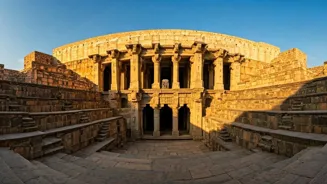Bara Imambara's Grandeur
The Bara Imambara in Lucknow is a prime example of Mughal architecture, and it is famous for its impressive central hall with a massive arched design.
The structure includes the Bhulbhulaiya, a mysterious labyrinth. The design of the Imambara features intricate details. This building is not only a religious space but also a testament to the engineering and design expertise of the era.
Chand Baori's Deep Descent
Chand Baori in Rajasthan stands out as one of the world’s deepest stepwells, demonstrating a fusion of function and art. Constructed in the 9th century, it features 3,500 narrow steps that descend 13 stories. The design ensured that water was easily accessible. It represents a sophisticated approach to water conservation and is a showcase of ancient Indian engineering.
Laxmi Vilas Palace Opulence
The Laxmi Vilas Palace in Vadodara is a remarkable architectural wonder built in the Indo-Saracenic style. Its size is impressive, as it is four times larger than Buckingham Palace, and it features elaborate interiors, along with large, sprawling grounds. The palace highlights the luxury and grandeur of its time, exhibiting the opulence of royal life through its design and structure.
Ibadat Khana's Harmony
In Fatehpur Sikri, the Ibadat Khana presents a unique perspective on religious harmony. Built by Akbar in the 16th century, it was designed as a hall for prayer and discourse. The design incorporates various elements that reflect an atmosphere of mutual respect and understanding. This building reflects Akbar’s vision for a united India.
Lepakshi Temple's Wonders
The Lepakshi Temple in Andhra Pradesh is celebrated for its stunning craftsmanship. It is particularly known for its hanging pillar and Veerabhadra temple carvings. This ancient temple is a testament to the skill and artistic achievement of the Vijayanagara period. The temple is a representation of the rich cultural and architectural legacy of India.
Adalaj Stepwell's Fusion
Adalaj Stepwell in Gujarat is an example of blended architectural styles. Constructed in the 15th century, the stepwell combines Islamic and Hindu architectural elements. The design is functional and artistic, as it provides a water source. It shows the fusion of architectural traditions and practical water management strategies.










